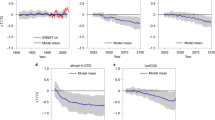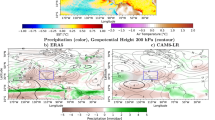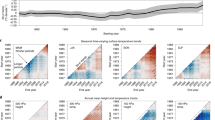Abstract
Since the mid-nineteenth century the Earth's surface has warmed1,2,3, and models indicate that human activities have caused part of the warming by altering the radiative balance of the atmosphere1,3. Simple theories suggest that global warming will reduce the strength of the mean tropical atmospheric circulation4,5. An important aspect of this tropical circulation is a large-scale zonal (east–west) overturning of air across the equatorial Pacific Ocean—driven by convection to the west and subsidence to the east—known as the Walker circulation6. Here we explore changes in tropical Pacific circulation since the mid-nineteenth century using observations and a suite of global climate model experiments. Observed Indo-Pacific sea level pressure reveals a weakening of the Walker circulation. The size of this trend is consistent with theoretical predictions, is accurately reproduced by climate model simulations and, within the climate models, is largely due to anthropogenic forcing. The climate model indicates that the weakened surface winds have altered the thermal structure and circulation of the tropical Pacific Ocean. These results support model projections of further weakening of tropical atmospheric circulation during the twenty-first century4,5,7.
This is a preview of subscription content, access via your institution
Access options
Subscribe to this journal
Receive 51 print issues and online access
$199.00 per year
only $3.90 per issue
Buy this article
- Purchase on Springer Link
- Instant access to full article PDF
Prices may be subject to local taxes which are calculated during checkout




Similar content being viewed by others
References
Houghton, J., et al. Climate Change 2001: The Scientific Basis (Cambridge Univ. Press, Cambridge, UK, 2001)
Rayner, N. A. et al. Global analyses of sea surface temperature, sea ice, and night marine air temperature since the late nineteenth century. J. Geophys. Res. 108(D14), 4407, doi:10.1029/2002JD002670 (2003)
Knutson, T. R. et al. Assessment of twentieth-century regional surface temperature trends using the GFDL CM2 coupled models. J. Clim. (in the press)
Held, I. M. & Soden, B. J. Robust responses of the hydrological cycle to global warming. J. Clim. (in the press)
Knutson, T. R. & Manabe, S. Time-mean response over the tropical Pacific to increased CO2 in a coupled ocean-atmosphere model. J. Clim. 8, 2181–2199 (1995)
Julian, P. R. & Chervin, R. M. A study of the Southern Oscillation and the Walker Circulation. Mon. Weath. Rev. 106, 1433–1451 (1978)
Tanaka, H. L., Ishizki, N. & Kitoh, A. Trend and interannual variability of Walker, monsoon and Hadley circulations defined by velocity potential in the upper troposphere. Tellus A 56, 250–269 (2004)
Webster, P. J. et al. Monsoons: Processes, predictability, and the prospects for prediction. J. Geophys. Res. 103(C7), 14451–14510 (1998)
Deser, C. & Wallace, J. M. Large-scale atmospheric circulation features of warm and cold episodes in the tropical Pacific. J. Clim. 3, 1254–1281 (1990)
Cane, M. A. & Sarachik, E. S. Forced baroclinic ocean motions, Part II: The linear equatorial bounded case. J. Mar. Res. 35, 395–432 (1977)
Barber, R. T. & Chavez, F. P. Biological consequences of El Niño. Science 222, 1203–1210 (1983)
Trenberth, K. E., Fasullo, J. & Smith, L. Trends and variability in column integrated atmospheric water vapor. Clim. Dyn. 24, doi:10.1007/s00382–005–0017–4 (2005)
Soden, B. J., Jackson, D. L., Ramaswamy, V., Schwarzkopf, M. D. & Huang, X. The radiative signature of upper tropospheric moistening. Science 310, 841–844, doi:10.1126/science.1115602 (2005)
Boer, G. J. Climate change and the regulation of the surface moisture and energy budgets. Clim. Dyn. 8, 225–239 (1993)
Allen, M. R. & Ingram, W. J. Constraints on future changes in the hydrological cycle. Nature 419, 224–228 (2002)
Delworth, T. L. et al. GFDL's CM2 global coupled climate models–Part 1: Formulation and simulation characteristics. J. Clim. 19(5), 643–674 (2006)
Wittenberg, A. T., Rosati, A., Lau, N.-C. & Ploshay, J. J. GFDL's CM2 global coupled climate models–Part 3: Tropical Pacific climate and ENSO. J. Clim. 19(5), 698–722 (2006)
Stouffer, R. et al. GFDL's CM2 global coupled climate models–Part 4: Idealized climate response. J. Clim. 19(5), 723–740 (2006)
Clarke, A. J. & Lebedev, A. Long-term changes in equatorial Pacific trade winds. J. Clim. 9, 1020–1029 (1996)
Jin, F.-F. An equatorial ocean recharge paradigm for ENSO. Part I: Conceptual model. J. Atmos. Sci. 54, 811–829 (1997)
Fedorov, A. V. & Philander, S. G. Is El Niño changing? Science 288, 1997–2002 (2000)
Harrison, D. E. & Vecchi, G. A. El Niño and La Niña–Equatorial Pacific thermocline and sea surface temperature anomalies, 1986–98. Geophys. Res. Lett. 28, 1051–1054 (2001)
Cardone, V. J., Greenwood, J. G. & Cane, M. A. On trends in historical marine wind data. J. Clim. 3, 113–127 (1990)
Ramage, C. S. Can shipboard measurements reveal secular changes in tropical air-sea heat flux? J. Clim. Appl. Meteorol. 23, 187–193 (1984)
Whysall, K. D. B., Cooper, N. S. & Bigg, G. R. Long-term changes in tropical Pacific surface wind field. Nature 327, 216–219 (1987)
Harrison, D. E. Post World War II trends in tropical Pacific surface trades. J. Clim. 2, 1561–1563 (1989)
Worley, S. J., Woodruff, S. D., Reynolds, R. W., Lubker, S. J. & Lot, N. ICOADS release 2.1 data and products. Int. J. Climatol. 25, 823–842 (2005)
Basnett, T. & Parker, D. Development of the Global Mean Sea Level Pressure Data Set GMSLP2 (Climate Research Technical Note 79, Hadley Centre, Met Office, Exeter, UK, 1997)
Kaplan, A., Kushnir, Y. & Cane, M. A. Reduced space optimal interpolation of historical marine sea level pressure. J. Clim. 13, 2987–3002 (2000)
Derber, J. & Rosati, A. A global oceanic data assimilation system. J. Phys. Oceanogr. 19, 1333–1347 (1989)
Acknowledgements
G.A.V. was supported by the Visiting Scientist Program at the NOAA/GFDL administered by UCAR. We are grateful to the model development teams at GFDL, and thank A. E. Johansson, M. P. Vecchi, T. Knutson, T. Delworth and J. Russell for comments and suggestions.
Author information
Authors and Affiliations
Corresponding author
Ethics declarations
Competing interests
Reprints and permissions information is available at npg.nature.com/reprintsandpermissions. The authors declare no competing financial interests.
Supplementary information
Supplementary Methods
This file contains additional details of the methods used in this study. (DOC 44 kb)
Supplementary Figure 1
Evolution of ΔSLP from GFDL-CM2.1 historical integrations. (PDF 428 kb)
Supplementary Figure 2
Statistical significance limits of single-member Δ SLP trends of different lengths, estimated from the 2,000-year control GFDL-CM2.1 integration. (PDF 595 kb)
Supplementary Figure 3
Two-sided confidence intervals on zero Δ SLP trend from pre-Industrial IPCC-AR4 GCM control experiments. (PDF 359 kb)
Supplementary Figure 4
Linear trends of Δ SLP from IPCC-AR4 models. (PDF 276 kb)
Supplementary Figure 5
Modelled changes in equatorial Pacific oceanic currents. (PDF 688 kb)
Supplementary Figure 6
Evolution of equatorial Pacific thermocline depth and slope. (PDF 291 kb)
Rights and permissions
About this article
Cite this article
Vecchi, G., Soden, B., Wittenberg, A. et al. Weakening of tropical Pacific atmospheric circulation due to anthropogenic forcing. Nature 441, 73–76 (2006). https://doi.org/10.1038/nature04744
Received:
Accepted:
Issue Date:
DOI: https://doi.org/10.1038/nature04744
This article is cited by
-
Historical changes in wind-driven ocean circulation drive pattern of Pacific warming
Nature Communications (2024)
-
Robust changes in global subtropical circulation under greenhouse warming
Nature Communications (2024)
-
Antiphase change in Walker Circulation between the Pacific Ocean and the Indian Ocean during the Last Interglacial induced by interbasin sea surface temperature anomaly contrast
Climate Dynamics (2024)
-
Revisiting the equatorial Pacific sea surface temperature response to global warming
Climate Dynamics (2024)
-
The mean state of the tropical Pacific Ocean differed between the Medieval Warm Period and the Industrial Era
Communications Earth & Environment (2023)
Comments
By submitting a comment you agree to abide by our Terms and Community Guidelines. If you find something abusive or that does not comply with our terms or guidelines please flag it as inappropriate.



